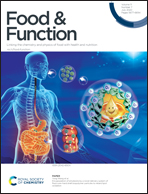Identification and molecular docking study of fish roe-derived peptides as potent BACE 1, AChE, and BChE inhibitors
Abstract
Acetylcholinesterase (AChE), butyrylcholinesterase (BChE), and beta-secretase 1 (BACE 1) play vital roles in the development and progression of Alzheimer's disease (AD). The objective of the present study was to identify fish roe-derived anti-AD peptides with activities against AChE, BChE, and BACE 1. Fish roe proteins were cleaved in silico by gastrointestinal proteases, and the released peptides were collected. Subsequently, the toxicity, solubility, and biological properties of these novel di- and tri-peptides were predicted and validated. Finally, potential anti-AD peptides were docked to targets, i.e., AChE, BChE, and BACE 1. A novel anti-AD tripeptide WIR with potent inhibition of AChE and BACE 1 was identified, with IC50 values of 43.32 ± 1.22 μM and 2.27 ± 0.35 mM, respectively. In addition, the inhibition rate of WIR (at a concentration of 1.06 ± 0.87 μM) against BChE was 33.5%, and the peptide WIR was able to simultaneously interact with AChE, BChE, and BACE 1. Residues Ser286 of AChE, Asp70 of BChE, and Thr231, Arg235 of BACE 1 played key roles in the interaction with peptide WIR. In summary, peptide WIR exhibits the potential to be an effective treatment for AD.



 Please wait while we load your content...
Please wait while we load your content...